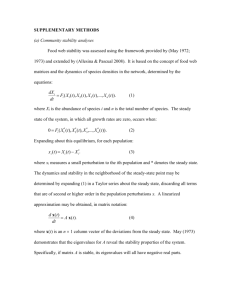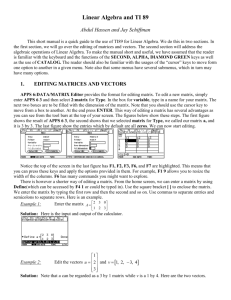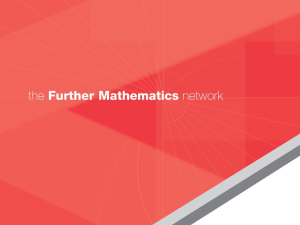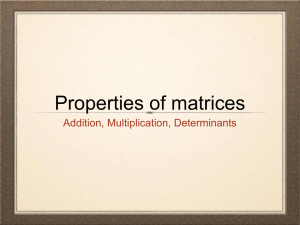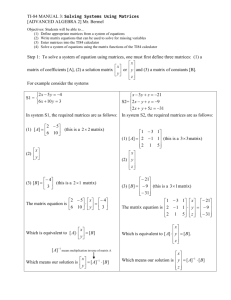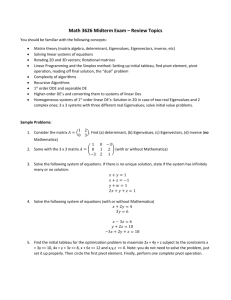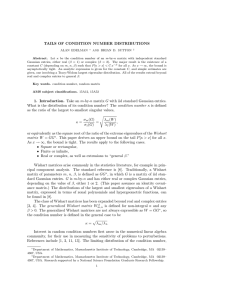Program with Abstracts - Large Networks and Systems Group
advertisement
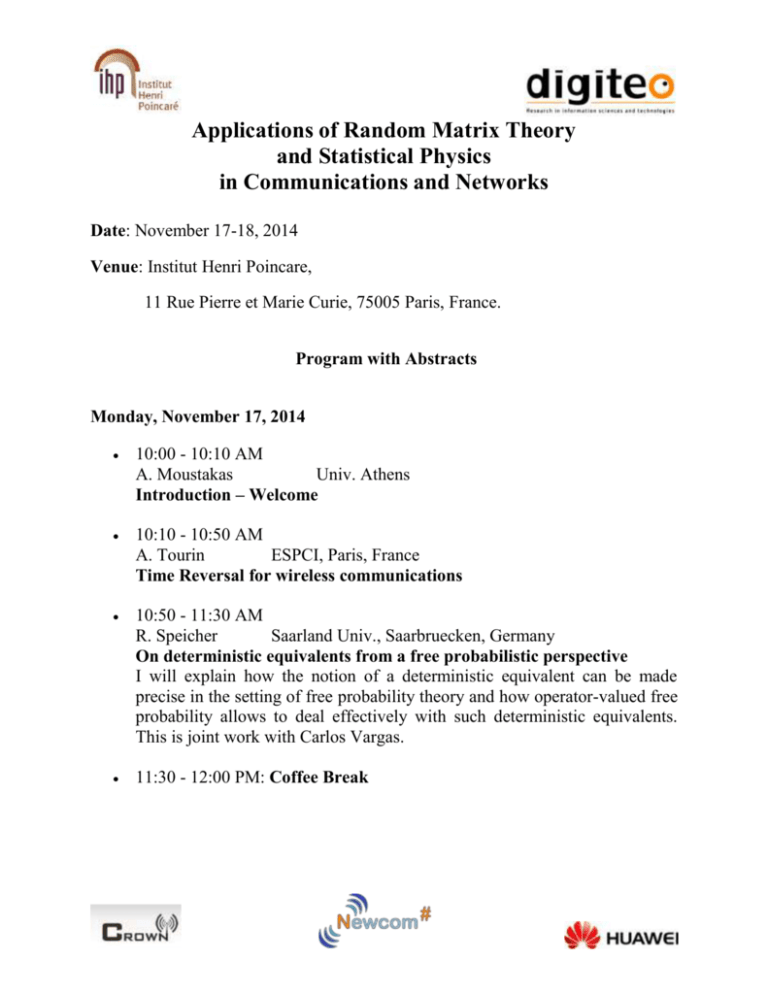
Applications of Random Matrix Theory and Statistical Physics in Communications and Networks Date: November 17-18, 2014 Venue: Institut Henri Poincare, 11 Rue Pierre et Marie Curie, 75005 Paris, France. Program with Abstracts Monday, November 17, 2014 10:00 - 10:10 AM A. Moustakas Univ. Athens Introduction – Welcome 10:10 - 10:50 AM A. Tourin ESPCI, Paris, France Time Reversal for wireless communications 10:50 - 11:30 AM R. Speicher Saarland Univ., Saarbruecken, Germany On deterministic equivalents from a free probabilistic perspective I will explain how the notion of a deterministic equivalent can be made precise in the setting of free probability theory and how operator-valued free probability allows to deal effectively with such deterministic equivalents. This is joint work with Carlos Vargas. 11:30 - 12:00 PM: Coffee Break 12:00 - 12:40 PM X. Mestre CTTC, Barcelona, Spain Linear spectral statistics of large sample coherence matrices and their application to the characterization of correlation tests for large observations We consider linear spectral statistics (LSS) of sample coherence matrices constructed from independent and identically distributed Gaussian observations. Using random matrix theory tools, we derive the first and second order behavior of these statistics assuming that both the observation dimension and the number of samples tend to infinity at the same rate. These results are then used to study the asymptotic performance of several binary hypothesis correlation tests that are widely considered in the literature. In particular, the Generalized Likelihoold Ratio Test (GLRT) and the Frobenius Norm (FN) tests are characterized and compared in this asymptotic framework. 12:40 - 1:20 PM S. Majumdar CNRS, Univ. Paris-Sud, France Phase transitions and edge scaling of number variance in Gaussian random matrices We study the probability distribution of the number of eigenvalues of a Gaussian random matrix that lie in a box [-L,L]. We show that the variance of the number of eigenvalues of a large matrix, as a function of the box size L, exhibits a dramatic non-monotonic behavior. It first increases with L logarithmically, then falls sharply as L crosses a critical value. We derive exact analytical results for large matrices using a Coulomb gas approach. Incidentally, our exact results also solve an outstanding problem of the counting statistics of free Fermions in a harmonic trap at zero temperature. 1:20 - 2:50 PM: Lunch Break 2:50 - 3:30 PM M. Debbah Huawei, France Random Matrices for 5G Communications 3:30 - 4:10 PM J. Najim Univ. Marne La Vallée, France Large Complex Correlated Wishart Matrices: Fluctuations and Asymptotic Independence at the Edges We study the asymptotic behavior of eigenvalues of large complex correlated Wishart matrices at the edges of the limiting spectrum. For this matrix model, the support of the limiting eigenvalue distribution may have several connected components. Under mild conditions, we will show that the extremal eigenvalue which converge almost surely towards the edges of the support fluctuate according to the Tracy-Widom law at the scale N2/3. Moreover, given several generic positive edges, we establish that the associated extremal eigenvalue fluctuations are asymptotically independent. Finally, when the leftmost edge is the origin, we prove that the smallest eigenvalue fluctuates according to the hard-edge Tracy-Widom law at the scale N2 (Bessel kernel). As an application, an asymptotic study of the condition number of large correlated Wishart matrices is provided. 4:10 - 4:50 PM G. Schehr CNRS, Univ. Paris-Sud, France Near extreme eigenvalues of large random Gaussian matrices and applications We study the phenomenon of ``crowding'' near the largest eigenvalue λmax of random NxN matrices belonging to the standard Gaussian ensembles, with Dyson index β. We focus on two distinct quantities: (i) the density of states (DOS) near λmax, ρDOS(r,N), which is the average density of eigenvalues located at a distance r from λmax and (ii) the probability density function (PDF) of the gap between the first two largest eigenvalues, pGAP(r,N). For GUE we compute these quantities exactly in terms of semiclassical orthogonal polynomials, which, as we show it, can be analyzed in the large N limit in terms of a Lax pair associated to the Painleve XXXIV equation. For generic index β, we provide a large N analysis of these quantities, including their asymptotic behaviors, using scaling arguments. As an interesting physical application, we show that, for GOE, these two quantities ρDOS(r,N) and pGAP(r,N) control the late time dynamics of the spherical Sherrington-Kirkpatrick spin-glass model. 4:50 - 5:20 PM: Coffee Break 5:20 - 6:00 PM L. Zdeborova CEA Saclay, France Statistical physics insight on matrix factorization 6:00 - 6:40 PM P. Vivo King’s College, London Universal Covariance Formula for Linear Statistics on Random Matrices 8:00 PM Dinner Tuesday, November 18, 2014 9:00 - 9:40 AM R. Mueller Univ. Erlangen, Germany On the optimum asymptotic multiuser efficiency of randomly spread CDMA 9:40 - 10:20 AM D. Challet École Centrale Paris, France Inference of implicit trader communication networks Traders are idle most of the time. What triggers their activity is an important open question, both theoretically and practically. We show here that their global activity is predictable, hence that the activity of some them triggers the activity of other traders. Our approach consists in clustering traders according to the similarity of their past activity, which amounts to find the implicit network that links their actions over time. We then use machine learning methods to predict traders’ activity. 10:20 - 10:50 AM: Coffee Break 10:50 - 11:30 AM R. Zecchina Politecnico di Torino, Italy Statistical physics of learning in large scale neural networks 11:30 - 12:10 PM D. Saad Aston Univ., UK Belief propagation based utilisation in Cognitive Radio Networks Cognitive Radio has been proposed as a key technology to significantly improve spectrum usage in wireless networks by enabling unlicensed users to access unused resource. We present new algorithms that are needed for the implementation of opportunistic scheduling policies that maximize the throughput utilisation of resources by secondary users, under maximum interference constraints imposed by existing primary users. Our approach is based on the belief propagation algorithm, which is advantageous due to its simplicity and potential for distributed implementation. We examine convergence properties and evaluate the performance of the proposed belief propagation algorithms via simulations and demonstrate that the results compare favourably with a benchmark greedy strategy. 12:10 - 12:50 PM F. Krzakala CNRS, ENS, Paris, France Featuring the non-backtracking operator 12:50 - 2:30 PM: Lunch Break 2:30 - 3:10 PM A. Tulino TBA Bell Labs, New Jersey, USA 3:10 - 3:50 PM L. Pastur Inst. for Low Temperatures, Kharkiv, Ukraine On the Qubits Dynamics in Random Matrix Environment We consider a quantum system consisting of two qubits and an environment, whose Hamiltonian is modeled by a large random matrix. The arborenvironment interaction is described by another large random matrix. We study the time evolution of the reduced density matrix of qubits, in particular the corresponding negativity, concurrence and quantum discord. It is shown that for various choices of the environment and initial entangled state of qubits the negativity and concurrence become zero at a finite moment (entangled sudden death phenomenon), while the discord vanishes only for t = 1. The dependence of these entanglement characteristics on the parameters of the model is also analyzed. 3:50 - 4:30 PM: Coffee Break 4:30 - 5:10 PM M. Nowak Univ. Krakow, Poland Signal from noise retrieval from one and two-point Green’s functions: A comparison 5:10 - 5:50 PM R. Couillet Supeléc, Gif-sur-Yvette, France Random Matrix Theory and Robust Estimation of Scatter In this talk, we will give an overview of recent findings in the large dimensional statistics of robust estimators of scatter. We will show that these non-conventional matrices behave asymptotically like standard random matrix models, therefore more amenable to theoretical analysis. The role of these estimators in outlier or impulsive noise rejection will be made clear and will serve as a lever to introduce several novel detection and estimation methods accounting for impulsive data.

